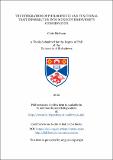Files in this item
The integration of phylogenetic and functional trait information into monocot biodiversity conservation
Item metadata
| dc.contributor.advisor | Meagher, Thomas Robert | |
| dc.contributor.author | McOwen, Chris | |
| dc.coverage.spatial | 108 | en_US |
| dc.date.accessioned | 2013-06-10T15:43:40Z | |
| dc.date.available | 2013-06-10T15:43:40Z | |
| dc.date.issued | 2012 | |
| dc.identifier | uk.bl.ethos.574776 | |
| dc.identifier.uri | https://hdl.handle.net/10023/3659 | |
| dc.description.abstract | It is now widely acknowledged that a high proportion of the world’s species are threatened with global extinction in the near future. Conserving all endangered species is impractical due to limited financial resources and manpower. Therefore, there is a real need to understand the mechanisms behind the extinction process in order to develop a proactive rather than reactive conservation strategy. Furthermore, given these limitations there is a need to be selective, prioritising species or areas not just on the basis of extinction risk or the number of species present, but with consideration for their role within the ecosystem. In this thesis, I investigate three aspects of current global extinction: What causes species to become threatened, how we should prioritise those that are, and how such information can be translated into area-based conservation priorities. Firstly, I developed models of plant extinction risk in relation to environmental (anthropogenic, climatic, and physical) variables and used them to show that non- randomness in extinction risk is highly influenced by interactions between the plants traits and their environment. Incorporating such interactions, my models were able to explain ~30% of the variation in plant extinction risk. Results from this large-scale comparative study suggest the biological traits that increase species’ susceptibility are dependent upon local environmental conditions. Secondly, I looked at how much unique evolutionary history, a proxy for species value, will be lost under current extinction patterns, whilst investigating how effective current conservation methods are at prioritising species based on their evolutionary value. The results are not promising; species threatened with extinction had disproportionately high quantities of unique evolutionary history. Furthermore, the IUCN Red List makes no allowance for this, for example, species considered Critically Endangered, the highest threat status under the IUCN Red List, may not necessarily be the most evolutionary unique. Finally, I looked at the relationships among species richness, versity (FD) and phylogenetic diversity (PD) as measures of biodiversity and therefore the conservation value of an area. It was found species richness is generally a good surrogate for FD and PD. However, agricultural development and climatic variation bring out discrepancies between species richness, FD and PD, challenging the claim of interchangeability of different diversity measures, with potential consequences for conservation planning. | en_US |
| dc.language.iso | en | en_US |
| dc.publisher | University of St Andrews | |
| dc.subject.lcc | QK86.A1O8 | |
| dc.subject.lcsh | Plants--Extinction--Mathematical models | en_US |
| dc.subject.lcsh | Plants--Extinction--Environmental aspects | en_US |
| dc.subject.lcsh | Conservation biology--Comparative method | en_US |
| dc.subject.lcsh | Biodiversity--Measurement | en_US |
| dc.title | The integration of phylogenetic and functional trait information into monocot biodiversity conservation | en_US |
| dc.type | Thesis | en_US |
| dc.contributor.sponsor | Biotechnology and Biological Sciences Research Council (BBSRC) | en_US |
| dc.type.qualificationlevel | Doctoral | en_US |
| dc.type.qualificationname | PhD Doctor of Philosophy | en_US |
| dc.publisher.institution | The University of St Andrews | en_US |
| dc.identifier.doi | https://doi.org/10.17630/10023-3659 |
This item appears in the following Collection(s)
Items in the St Andrews Research Repository are protected by copyright, with all rights reserved, unless otherwise indicated.

